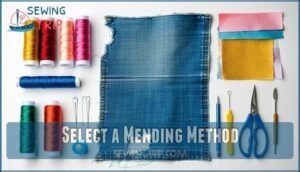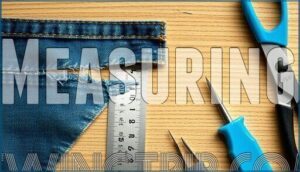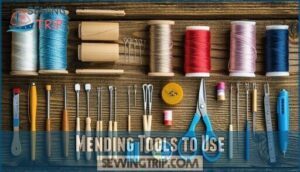This site is supported by our readers. We may earn a commission, at no cost to you, if you purchase through links.
 To sew a tear, first, assess the rip—flat edges are easier to repair than frayed ones.
To sew a tear, first, assess the rip—flat edges are easier to repair than frayed ones.
Trim loose threads, and clean the area if needed. Grab a needle and thread that match your fabric.
For smaller rips, use a simple running stitch: thread the needle, tie a knot, and weave it in and out along the tear. Pull gently to avoid puckering.
For larger holes, consider a patch—cut fabric slightly bigger than the tear, then sew it over the hole using a whip or zigzag stitch. Stitch carefully, and soon, it’ll look good as new.
Ready for more mending tricks?
Table Of Contents
Key Takeaways
- Trim loose threads and press the fabric flat before stitching to prevent fraying and ensure a clean repair.
- Match your needle and thread to the fabric type for durability and a seamless finish.
- Use a patch for larger holes and secure it with a strong whip or zigzag stitch.
- Reinforce weak spots with interfacing and use appropriate stitches like zigzag for stretchy fabrics.
Assess The Tear
Start by taking a close look at the rip—you’ve got to know what you’re up against. Pay attention to the rip characteristics: is it a clean rip, an open rip, or something in between? Check the fabric type too—delicate silk demands a gentler touch than rugged denim.
Understand the tear—clean or open—and match your approach to the fabric, from delicate silk to rugged denim.
Think about what caused the tear. Was it wear and tear, or a sharp edge that snagged it? Understanding the tear cause helps prevent future mishaps.
Next, examine the damage extent. Are there missing fabric pieces, or can the edges be brought back together? Every tear repair starts here. Evaluating repair feasibility guarantees you pick the right fix.
Get this part right, and sewing the tear becomes much easier down the line!
Prep The Torn Area
Preparing the torn area is like setting the stage for a clean, lasting repair.
Setting the torn area right ensures a seamless repair that’s both durable and professional.
Taking these steps guarantees your tear repair looks professional and holds up over time:
- Trim Loose Threads: Use sharp scissors to carefully remove frayed edges. This prevents more unraveling.
- Ironing Technique: Press the fabric flat with an iron set to the correct heat for the material. Smooth fabric is easier to sew.
- Interfacing Use: Reinforce weak spots with iron-on interfacing, especially for clean rips or thin fabric.
- Grain Matching & Stretch Consideration: Align the fabric grain and account for any stretch to keep the repaired area natural-looking.
These steps set you up for success when you mend clothing or tackle other sewing repairs.
Select a Mending Method
Choosing the right mending method depends on the type of tear and the tools you have on hand.
Whether you use hand stitching for precision or a sewing machine for speed, matching the technique to the fabric guarantees a durable repair.
Hand Stitching
With your fabric prepped, grab a sharp needle to match the tear’s material.
Thread it with strong, matching thread, and secure it with a neat knot. A simple running stitch pulls fabric edges together—keep your stitches small and even.
For stronger seams, overlap with a backstitch. Mending clothing visibly? Use a blanket stitch for flair.
Selecting the right hand sewing needles is essential for different fabric types and mending tasks.
Keep fabric taut while sewing the tear, ensuring smooth, durable, professional-looking results. Happy stitching!
Machine Stitching
Machine sewing makes fixing a tear quicker and neater.
Set your tension carefully to avoid puckering, and pick the right needle for your fabric type.
Use a zigzag stitch for strength or a straight stitch within the seam allowance for a discreet look.
Backstitch at both ends to secure.
Selecting proper needles is essential for the best results.
Let the presser feet guide the fabric feed smoothly, ensuring even stitches with consistent control over your repair.
Stitch The Tear
Once you know the mending method, it’s time to stitch the tear. A steady hand works wonders here. Choose a stitch type—straight stitch for clean rips or zig-zag for stretch fabrics. Check your thread tension; too tight could pucker the fabric, but too loose won’t hold. Match your needle choice to the fabric’s weight.
Here’s a simple process:
- Align the Edges: Press them together, ensuring no puckering or overlap.
- Sew in the Right Direction: Go with the fabric grain for a smooth finish.
- Finish the Seam: Backstitch at both ends for durability, and trim loose threads.
Take your time, and remember: sewing a tear properly now saves trouble later. Repair fabric with care for a lasting fix.
Patch Larger Holes
Patching larger holes takes a bit of patience, but it’s easier than you think with the right steps.
You’ll measure the hole, secure the patch, and stitch it firmly to create a strong, neat repair.
Measuring
Start by taking accurate measurements of the tear, noting its length and width. Add at least 1.5 inches to the pre-repair size to account for seam allowance.
Lay the repair fabric flat, aligning the fabric grain for strength. Use reliable measuring tools to guarantee precision.
Cut your patch carefully, with rounded edges to avoid fraying. This step guarantees your sewing tear fix will look seamless and last a long time.
Securing Patches
Before stitching, secure the fabric patch under the tear using pins or basting stitches. This guarantees proper alignment and patch adhesion.
Choose a clothing patch that matches the fabric compatibility of your item. For stronger results, consider decorative stitch patterns, like blanket stitch, or zigzag edges for smoother edge finishing.
Iron-on patches offer quick adhesive options but may need extra stitching for durability. Consider using fabric patch options for unique designs.
Reinforce the patch with straight stitches along seams to keep everything intact during wear and washing, ensuring a durable finish.
Creative Mending Ideas
After patching larger holes, why not turn mending into an art form? Visible mending combines function with creativity, letting you add flair to your repairs while extending the life of your clothes.
Here’s how you can make fabric tears a canvas for self-expression:
- Add decorative patches: Use bold, patterned fabric patches to cover tears. For a cleaner look, sew the patch underneath or try reverse appliqué for a peek-through effect.
- Embroidered repairs: Stitch flowers, stars, or geometric designs around holes for a charming finish.
- Patchwork designs: Use colorful fabric scraps or jean patches to create textured layers that pop.
- Textile art: Experiment with sashiko or contrasting stitches for subtle artistry.
- Upcycled fashion: Incorporate quirky details like old buttons, lace, or sequins for a playful touch.
Your repairs become one-of-a-kind creations!
Mending Tools to Use
Before you repair a tear, gather the right tools—quality makes a difference. Choose needles based on the fabric: thicker ones for denim, finer ones for silk. Keep a variety handy.
For thread types, match the thread’s strength and color to your fabric. Waxed thread helps avoid tangling, while cotton thread works well for most projects.
A sharp pair of scissors trims threads cleanly; pinking shears prevent fraying. If you don’t have pins, use safety pins or clips to hold fabric in place.
A thimble adds safety when sewing thicker materials. Mark your stitching lines with chalk or a washable pen. Consider investing in portable mini scissors or irons for added convenience.
Frequently Asked Questions (FAQs)
How do you sew a tear rip?
Imagine smoothing wrinkles on a crumpled page—press torn fabric flat, trim loose threads, and align edges.
Use a needle and matching thread, stitching neatly.
Reinforce with interfacing if needed, ensuring durability and a clean finish.
How to repair small tears on fabric?
Start by trimming loose threads and pressing the tear flat.
Align the edges, secure with pins, and use a needle and thread to sew small, neat stitches across the rip.
Press for durability.
How do you resew a tear in a sewing machine?
Position the tear under the presser foot, aligning edges neatly.
Use a straight stitch, sewing slowly to stay precise.
Backstitch at both ends for strength, then trim loose threads and press for a clean finish.
How do you stitch a tear in fabric?
Did you know fabric tears are as common as spilled coffee?
Flatten the tear, trim loose threads, then stitch it using matching thread.
For strength, overlap stitches slightly or use a reinforcing patch underneath.
How do you fix a rip or tear in fabric?
Trim loose threads, press the fabric flat, and align edges smoothly.
Use matching thread to stitch over the rip with a straight or zig-zag stitch.
Reinforce with interfacing if needed, then press for a clean finish.
How do you sew a rip?
Did you know 90% of torn fabric rips can be repaired at home?
Flatten the rip with an iron, trim loose threads, and sew steadily with matching thread.
A zig-zag stitch prevents further fraying!
How do I pick the right needle for the material I’m sewing?
Choose a needle that matches your fabric’s weight and type.
Light fabrics need thinner needles, like size 9 or
Heavy materials require thicker ones, like size
Use sharp needles for woven fabrics and ballpoint for knits.
How do you repair frayed fabric edges?
A stitch in time saves nine.
To repair frayed edges, trim loose threads, press the fabric flat, apply interfacing underneath, and use a zig-zag or overlock stitch to secure and prevent further unraveling.
What is the best stitch for stretchy fabrics?
Use a zigzag stitch or a stretch stitch to sew stretchy fabrics.
They let the material move without breaking the thread.
Pair it with a ballpoint needle for smooth stitching through elastic fibers.
How can you prevent fabric tearing again?
Reinforce weak spots with interfacing or double fabric layers, especially in stress-prone areas.
Avoid overloading pockets or pulling seams.
Keep clothes moth-free, wash gently, and repair small snags early to stop tears from growing, using methods that prevent further damage and maintain the garment’s integrity, focusing on being moth-free.
Conclusion
Fixing a rip might feel like tackling a mountain at first, but knowing how to sew a tear makes it much simpler.
With careful stitching or patching, you’ll restore your fabric’s strength and look.
Choose your tools, stitches, and methods wisely to match the tear, and don’t rush—precision matters more than speed.
Practice mending smaller rips before tackling larger holes, whether it’s hand stitching or creative patchwork, you’ve got all the skills to sew tears like a pro!












